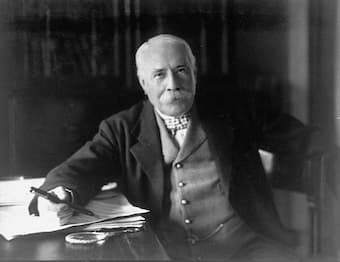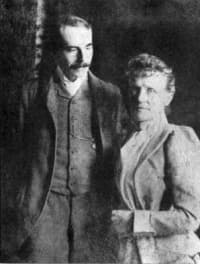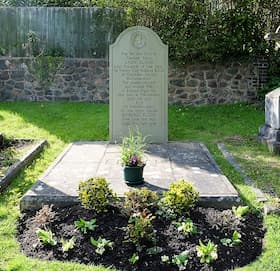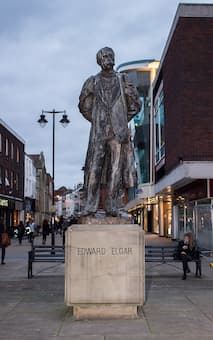
Sir Edward Elgar
A contemporary newspaper reported, “No soldiers paraded, no trumpets blared, no drums rolled out an elegy. But throughout the Western World last week a mighty marching tune reverberated. Sir Edward Elgar, 76, was dead on 23 February 1934.” During an operation on 8 October 1933, doctors had discovered that the sciatic pain from which he suffered was caused by inoperable colorectal cancer.

Apparently, Elgar told his consulting doctor Arthur Thomson, “that he had no faith in an afterlife… I believe there is nothing but complete oblivion.” His condition quickly worsened, and he left a symphonic work and an opera incomplete. He died, after being given the last sacrament, on 23 February 1934. Elgar was born in the village of Lower Broadheath, in the Malvern Hills district of Worcestershire, England, and he wanted to be buried there. He made his daughter promise to not give him a pompous London funeral but to bring his body home. True to his wishes, he was buried next to his wife at St Wulstan’s Roman Catholic Church in Little Malvern.
Edward Elgar: Enigma Variations, “Nimrod”

Sir Edward Elgar and the London Symphony Orchestra
on the platform of the Queen’s Hall
Elgar had struggled with a variety of health problems throughout his life, including neuralgia, colds and influenzas. A biographer writes, “sometimes he was in bed for a day or two, at other times for much longer. Sometimes he called the doctor; at other times he took the waters at Llandrindod Wells. In early January 1892, Elgar succumbed to a serious viral infection. He initially took to bed for 6 days, but his flu symptoms were getting worse and he first managed to go downstairs only on 26 January. The doctor had to be called a couple more times, and Elgar first stepped outside the house on 7 March, roughly 2 months after the initial infection. In the year prior, Elgar had suffered from severe tonsillitis and was confined to bed in extreme pain. Apparently, the doctor lanced his throat, and Elgar gradually started to recover. His tonsils flared up again in 1918, and Elgar was sent to Sir Stanley Melville in London to have his throat x-rayed. “His tonsils were condemned. Surgeon Mr. Tilley removed them in a nursing home in Dorset Square on 15th March.”
Edward Elgar: “Suite” from the unfinished opera The Spanish Lady, Op. 89

Edward and Alice Elgar, c. 1891
Alice Elgar wrote in her diary, “A long day of suspense as the operation was not till 3 P.M. E. was very calm, & bore the long suspense wonderfully. Then the nurse came & injected something in his arm to dry up saliva &c. Then Sir Maurice fetched him & he went downstairs so simply & cheerfully – A. went down to waiting room & as she entered just caught a glimpse of E. in his blue dressing gown, entering the Theatre – A. spent an anxious horrible 40 mins. Then Sir M. & Tilley came & told her all was well. Sir M. showed her the worst tonsil all over abscess matter & a black stone, pea size, in it. A. not let to go up so went home, returned at 7. found E. in great pain not knowing how to bear it, agonising to A. They gave him an injection & in 10 mins he was sleeping peacefully.”
Edward Elgar: Severn Suite, Op. 87 (London Symphony Orchestra; Richard Hickox, cond.)

Elgar’s grave in Little Malvern
During his retirement, Elgar had composed suites, arrangements and some theatre music, but according to scholars, “his most valuable work lay in the recording studio.” The Gramophone Company headed by Fred Gaisberg had engaged Elgar in conducting the vast majority of his instrumental music. “From the acoustic records of 1914 to the last electric records of 1933, Elgar wholeheartedly cooperated, and the result is a superb series, unrivalled in documentary significance… Elgar only occasionally conducted other composers’ music; in his own he was unmatched for eloquence, vitality and justness of proportion.”

Statue of Elgar in Worcester
In addition, Elgar was urged to complete the oratorio trilogy in his seventies, but “because of spiritual disillusion, ‘The Last Judgement’ did not come about.” George Bernard Shaw revived Elgar’s interest in opera, and Sir Barry Jackson, the director of the Malvern Festival, was tasked to produce a libretto for “The Spanish Lady” from Ben Jonson’s The Devil is an Ass. And in 1932, the BBC commissioned a Third Symphony, which was left incomplete but has since been reconstructed. Elgar is commemorated in a window based on “The Dream of Gerontius” in Worcester Cathedral and a tablet in Westminster Abbey. In 1938 his birth cottage at Broadheath opened as a museum.
For more of the best in classical music, sign up to our E-Newsletter
Edward Elgar: Sketches for Symphony No. 3 elaborated by Anthony Payne
